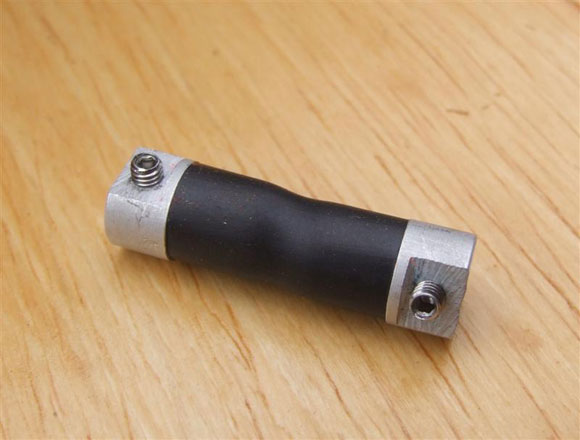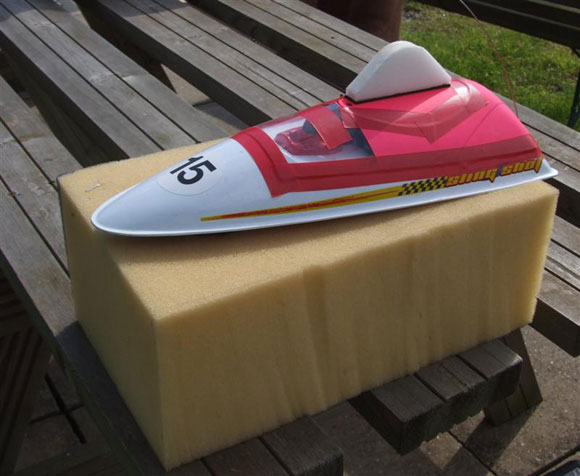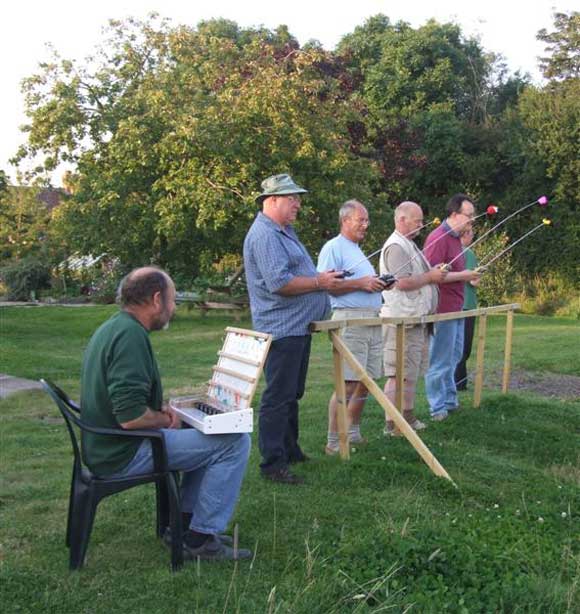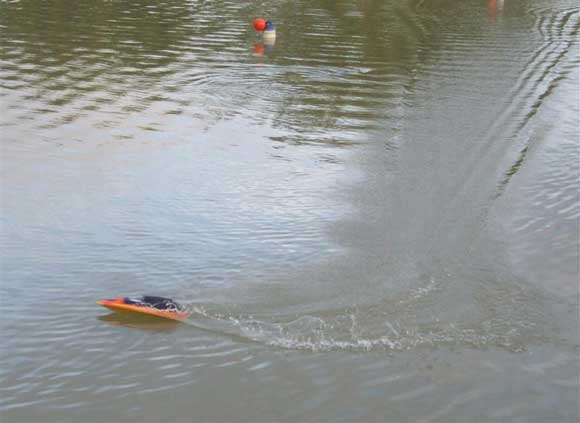In the 2006 Kits Special I reviewed Sling Shot, which is a ready to run (RTR) fast electric speedboat sold complete with r/c, motor and drive battery and all that is needed are dry cells for the transmitter. Since then the Knightcote Model Boat Club has run a full racing series with around a dozen members running a boat each. Needless to say, once we bought the models we couldn’t resist fiddling with them in some way, so I thought that it would be useful to show just what can be done with a basic RTR model. Fixing problemsThe first type of common alterations were those needed to fix problems experienced with the boats. Very early on, several members found that the coupling between motor and propshaft worked lose. An engineer amongst our group started to offer a service where the pan headed screws fitted as standard were replaced with proper grub screws , Photo 1. This allows them to be tightened up more easily and firmly. Combine this with a flat area filed on the end of the propshaft and you get a good solid grip. An alternative method is to drip superglue onto the coupling and quickly re-assemble the driveline. It’s not proper engineering of course, but also seems to be good enough, but makes dismantling difficult. Another issue is that if enough water gets in the boat, it can destroy the speed control attached to the back of the motor. You know you are in trouble when you have only one speed full tilt! After killing one unit, I carefully unsoldered its replacement and re-attached it via some flyleads. This allowed the speed control to be sealed in a plastic bag, Photo 2. To carry out these modifications you need to remove the top of the boat. This is held down by some pretty stickers which disintegrate if removed and replaced a couple of times. The solution is to tape the top down. Electrical insulating tape is ideal as it seems to give a waterproof seal, bends around the curves of the model and can be easily removed next time you need to get inside.
Article continues below…
Enjoy more Model Boats Magazine reading in the monthly magazine. Click here to subscribe & save.
|
|
Fixing the lidTo change the battery, Sling Shot features an oval rubbery plastic bung which fits in the top cover. Fairly early on we discovered that this lid doesn’t float. In fact if anyone would care to dredge our pond there are several down there somewhere. The keen racer will use more insulating tape to seal this and keep the water out. You’ll be surprised how far a Sling Shot can run submerged, or how long it can sit upside down without problems. Sorting this problem causes another. The on/off switch is inside, so preparation for a race involves hurried work with tape unless you had the foresight to fit an external switch. In Photo 3 you can see the switch I fitted to my boat. This one came from a radio control car specialist, but others are available. Of course if your lid is at the bottom of the pond you need a replacement. You can order one from Ripmax who distribute the boat, or if there is a handy carpenter in your midst, get him to make up a wooden alternative and this is lighter and it floats. You still need to tape it down to keep the water out, but it’s a start, Photo 4. Self-rightingSling Shot racing is supposed to be a non-contact sport, but some drivers are better than others. Occasionally boats will flip and while all the tape will keep the water out and therefore the model on the surface, several racers decided to try and built self-righting devices. These usually take the form of a fin on the lid. Fins are made from either balsa wood, Photo 5, or dense plastic foam, Photo 6. To be honest the jury is out on how well they work, but if there is a chance that you can keep going after an incident then they are worth the effort. What they certainly do is to make the boat more visible on the other side of the course, which can make a big difference in a race.
|
|
DecorationOnce the stickers holding the top down have disintegrated and you are using tape, the artist in you takes over and you want to decorate the boat. A quick trip to the spray paint section at Halfords (a motorist accessory store in most UK towns) will do for most of us, but some people really go to town, Photo 7. In this case the decoration is with a combination of paint and custom vinyl stickers. Striking decoration has a distinct purpose when there are half a dozen boats hurtling around because you don’t want to be trying to guess which one is yours. Even on a small lake like ours, these low-slung boats can be difficult to see when they sail as a pack. The only rule for painting is that there must be a clearly identifiable number on the nose of the model. A club member produced a set of vinyl stickers, one of which was provided to every entrant, but I used a number from a hardware shop intended for a door which also worked well. RacingThe races themselves are simple enough. Each heat consists of up to six boats travelling around the water in a clockwise direction. Drivers stand in an approved area, Photo 8, to ensure everyone has an unobstructed view. As they pass the race umpire, each racer calls out his or her number. The umpire has a series of counters, to record the laps and the totals are then noted, Photo 9. There are normally two heats lasting for four minutes each and then a final for the fastest boats from these. This final heat lasts five minutes. Sling Shot batteries are good for ten minutes, but most people carry a spare so they have fresh cells for the last race. The total laps are recorded over the year, with those from the best five races counting toward a final score. This years winning total was 169 with the next three boats coming within eight laps of this. A race marshal issues penalties for bumping or cutting inside buoys. Infringement of the rules results in laps being deducted. Losing half a lap for a missed buoy focuses the mind on sticking to the course.
|
|
How to win?OK, you fancy having a go, but how do you win ? Well, since I won the 2007 series, perhaps I can claim a little expertise. First, don’t fiddle with the boat too much. Our rules don’t allow many alterations, no hot motors for example, but keeping it simple does pay dividends. Those who have fiddled with the mechanics have been known to stop halfway through the race with smoke coming out of the top hatch, which is bad news in a plastic boat! Practise is the best way of learning. With all the boats running the same motors there is no chance of overtaking by pure grunt, so you have to do it by avoiding mistakes. These boats are agile and a twitch at the wrong time means you swing out wide on a corner, or worse run inside a buoy and take a penalty. The racer who can keep out of trouble and just clock up the laps without incident will win. When the boats are furthest away from the control positions it can be difficult to judge the turns, but putting in practise laps on your own makes a big difference. Stay out of trouble. Racing for the first corner at the start is likely to mean getting mixed up in a tangle of boats, or at least it does with some of our members. If you aren’t confident of getting there first, hang back and avoid the carnage that occasionally occurs. Hitting fish isn’t clever either, but the boats usually survive this even if they do leap out of the water. As far as I’m concerned, any carp that gets clobbered in our lake deserves all it gets. Push the trim on the throttle up. I’m not really sure if this actually makes a difference, but like the other favourite of the KMBC hot-shots, namely waxing the bottom of the boat, you think it does and perhaps that makes the difference. ConclusionWhy would you want to do this? Because it’s fun. None of us are very good, but we enjoy it. With ten possible race sessions during the season it’s a great way of bringing club members together. The races don’t take very long, so most people bring another boat to sail for fun as well. Before this, getting ten members to the water at the same time was a rare event. With the Sling Shots it happened a couple of times a month. Using a ready to run boat means everyone can get involved. A cheap model with xtal control like this, needs nothing more than slapping a number on the nose to turn an ordinary modeller into Lewis Hamilton’s aquatic equivalent (sort of). Mind you, the racing becomes infectious and the benches around the lake start to look like a F1 pit lane, Photo 10. Of course if you really don’t fancy racing, there is always the towing competition, Photo 11. I wonder if I could fit a sail and join in yacht racing? Price is around £40 complete and Sling Shot is distributed in the UK by Ripmax Models.
|
Sling Shot
by
–
Advert
Enjoy more Model Boats Magazine reading every month. Click here to subscribe.
Article Tags:







